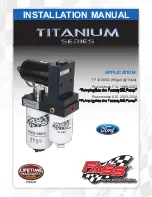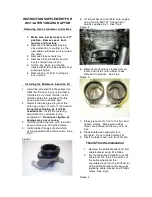
4
CAUTION: TO REDUCE THE RISK OF INJURY OR PROPERTY DAMAGE:
•
Never look directly into the laser beam or shine the laser beam into another person’s eyes.
•
Keep sharp objects away from the unit.
•
Do not expose this unit to extremely high temperatures.
•
Do not drop or throw the unit.
•
Use only with AC adapter provided with the unit. Plug in the adapter at the unit first, then plug into the power source.
•
Do not attempt to power the unit if the AC adapter is damaged – return the AC adapter to manufacturer for repair or replacement.
•
To reduce risk of damage to electric plug and cord, pull by plug rather than cord when disconnecting.
•
Do not crush, cut, pull or expose the AC adapter cord to extreme heat.
•
Position the AC adapter cord so it does not become entangled or become a safety hazard. Keep the AC adapter cord away from sharp
edges.
•
Install in a location inaccessible to children or pets.
•
When not in use, the unit should be stored in a dry, well ventilated place out of the reach of children or pets.
Inspection and repairs
•
Before use, check the unit for damaged or defective parts. Check for breakage of parts, damage to DC port and any other conditions
that may affect its operation.
•
Do not use the unit if any part is damaged or defective.
•
Have any damaged or defective parts repaired or replaced by the manufacturer.
•
Never attempt to remove or replace any parts, other than those specified in this manual; and never attempt to disassemble the main
body of the unit. Other than the three AA dry cell batteries, there are no user-replaceable parts.
ALKALINE BATTERY SAFETY INSTRUCTIONS
WARNING: Batteries can explode, or leak, and can cause injury or fire. To reduce this risk:
•
Use only AA alkaline dry cell batteries in this unit.
•
Carefully follow all instructions and warnings on the battery label and package.
•
Always insert batteries correctly with regard to polarity (+ and –), marked on the battery and the equipment. Failure to insert batteries
in the correct polarity, as indicated in the battery compartment, may shorten the life of the batteries or cause batteries to leak. There is a
danger of explosion if batteries are incorrectly replaced.
•
Do not short battery terminals.
•
Do not charge batteries.
•
Do not mix old and new or alkaline, standard (carbon-zinc) and rechargeable (nickel cadmium or nickel metal hydride) batteries. Replace
all of them at the same time with new batteries of the same brand and type.
•
Remove dead batteries immediately and dispose of per local codes.
•
Do not dispose of batteries in fire.
•
Keep batteries out of reach of children.
•
Remove batteries if the device will not be used for several months.
“Transporting batteries can possibly cause fires if the battery terminals inadvertently come in contact with conductive materials such
as keys, coins, hand tools and the like. The US Department of Transportation Hazardous Material Regulations (HMR) actually prohibit
transporting batteries in commerce or on airplanes (i.e. packed in suitcases and carryon luggage) UNLESS they are properly protected
from short circuits. So when transporting individual batteries, make sure that the battery terminals are protected and well insulated from
materials that could contact them and cause a short circuit.”
SAVE THESE INSTRUCTIONS
INTRODUCTION
Congratulations on purchasing your new
Stanley® Accupark™ Dual Garage Laser Parking Assist.
Read this instruction manual and
follow the instructions carefully before using your new Garage Laser Parking Assist.
POWER SUPPLY
The Garage Laser Parking Assist is powered by either the
AC adapter or, in the case of a power outage, by the three
AA alkaline dry cell batteries (not included) inside the
battery compartment.
Installing the backup batteries
1. Push the battery compartment cover latch to remove the battery compartment cover from the battery compartment.
2. Insert the batteries correctly according to the polarity symbols shown inside the battery compartment, observing the cautions that follow.
3. Replace and snap the battery compartment cover into the Garage Laser Parking Assist through the Battery Compartment Cover Latch.
5
CAUTION: TO REDUCE THE RISK OF INJURY OR PROPERTY DAMAGE:
•
Always read and follow all warnings in the "Alkaline Battery Safety Instructions" section of this instruction manual before replacing and/
or disposing of the batteries in this unit.
•
Do not use foreign objects when installing or removing batteries; always gently insert or remove the batteries by hand.
•
Make sure the AC adapter is disconnected when installing or replacing the batteries.
•
Make sure the batteries are installed in the battery compartment BEFORE mounting the unit to the ceiling or a wall surface.
•
When the batteries are properly installed and AC Adapter is plugged into the unit, the unit will use the AC power source as the primary
power source and the AC power LED indicator will light red.
•
The AC power LED indicator inside the motion sensor will not light when the batteries are being used as the power source.
•
The three AA alkaline batteries are intended to be used only as a backup when the AC power is interrupted; and will not last for more
than a few days.
Connecting the 120 Volt AC adapter
1. Once you have installed the batteries in the unit and mounted it as desired, insert the barrel connector of the AC adapter into the DC
power port on the side of the unit.
2. Insert the plug into a (powered) standard North American 120 volt 60Hz outlet.
3. The AC power LED indicator inside the motion sensor will light red to indicate the unit is properly connected and ready to use. When
the AC adapter is disconnected or AC power is interrupted, the AC power LED indicator will shut off.
Notes:
When the AC adapter is properly connected to both of the unit and functioning AC outlet, the unit will use the AC power source as the primary power
source. If the AC adapter is disconnected or AC power is interrupted, the unit will continue to operate, automatically drawing power from the three
AA alkaline batteries (if the batteries have been installed). Once the AC power returns, the unit will then resume primary (AC) power source.
Make sure to connect the AC adapter to both of the unit and AC outlet AFTER the unit is mounted.
MOUNTING THE UNIT
The Garage Laser Parking Assist can be mounted on the ceiling or a flat wall
surface using the supplied mounting bracket, screws and wall anchors, as follows:
1. Cut out the paper template on the inside back cover of this instruction
manual and tape it to the ceiling or a flat wall surface near a functioning
AC outlet. Make sure the location meets the requirements set out in the
"Important Safety Instructions" section at the front of this manual. Align the
screw hold circles on the paper template horizontally so that the mounting
bracket is mounted level and does not slope.
2. Using a 6mm diameter bit, drill one hole for each of the center screw hole
circles on the paper template to a depth of approximately 30-35mm.
3. Remove the paper template.
4. Install one of the wall anchors in each of the holes. Check that the wall
anchors are fully and securely inserted into the wall.
5. Make sure the mounting bracket is mounted in the correct direction. Align
and screw one of the screws into each of the anchors through the three screw
holes in the mounting bracket. Do not over-tighten.
6. Slide the Garage Laser Parking Assist into the mounting bracket, with the four
tabs on the mounting bracket fitting into the four locking slots on the unit, as
shown below:
CEILING OR FLAT WALL SURFACE
CAUTION: TO REDUCE THE RISK OF PRODUCT DAMAGE:
•
Only use the mounting bracket for mounting the Garage Laser Parking Assist. The mounting bracket is not intended to support
additional weight. Do not attach anything to or hang anything from the mounted Garage Laser Parking Assist.
GLPS_ManualEN_051616.indd 4-5
5/16/2016 10:47:24 AM
























